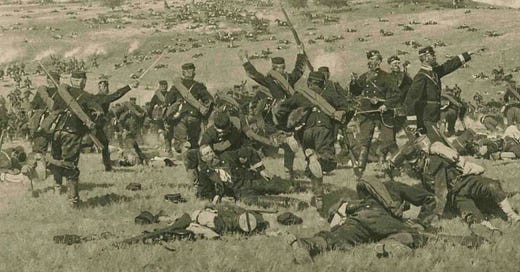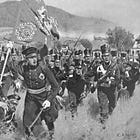This is the fifteenth post in a multi-part series. To find previous installments and those that follow, please consult the following guide.
Now let us get back to my 1st Regiment. Already I had heard sounding from their side the inspiring call, ‘Fix bayonets!’ Already I saw the 3rd Battalion in two deep lines advance by companies to the strains of the Prussian March.1
The firing line, which till now had been quietly searching the enemy’s position with volleys, grew excited. Impulsively, parts of it drew closer to the enemy. When the entire line had made a rush forward, the supports of the center companies of both battalions went up into it, rushed forward with their platoons already in the firing line, and opened a combined double-rank fire. When the other companies had aligned themselves with these, they were about 200 or 250 yards from the enemy.
The latter also had thrown reinforcements into his firing line. Although our concentrated volleys were directed each time against those points where from behind the smoke dark masses of the enemy could be seen advancing, still these brave men succeeded in gradually forming a second rank behind the shelter trench. This rank knelt and fired over the front rank.
The shelter trenches were partially useless, because of the number of dead and wounded in them.
Our artillery, which had advanced by batteries over the brook, was pelting the village and the ground behind it with shrapnel and shell.2
The fire was causing enormous losses on both sides, and the decisive moment could not long be delayed. The companies of the 3rd Battalion had reached the protecting foot of the height, and their front line was visible on the crest. It was now the time for the battalions in the fighting line to throw in their last reserve.
The two battalions did this in different ways. The first battalion used up its last company by fragments in the further reinforcing of the firing line by sending a platoon to each of its wing companies.
This was the first time that platoons of different companies had been mixed together. This was allowed in pressing cases. If under these circumstances a platoon was placed between two platoons, both belonging to the same company, it had to consider itself as part of that company. If it was between two platoons of different companies, it acted independently.
The commander of the 2nd Battalion considered the decisive moment to have arrived. The left flank being covered by the 2nd Regiment, he had already drawn the reserve of the left, i.e., the 8th company, behind the center of the battalion, and now brought it up in line to the final attack. The color was in front, the drums beat, and the buglers blew continuously the ‘Advance’. The firing line burst into magazine fire.
Fifty yards from the firing line the 8th company brought the rifles down for the charge. The firing line rose and advanced at the storm march. They did not, however, cease firing entirely, for the front rank advanced by platoons at the double about twenty paces, and then fired a volley standing. The first battalion seeing the movement immediately took up the attack.
This moment, when all of the attacking forces were in movement, was that selected by the defense for a last and decisive blow. Single platoons came out of the burning village, and entire companies on the flanks, in order to give a massed fire.
‘Halt and fire!’ I shouted, on sighting the enemy’s reserve. “Just a few magazine volleys - then - hurrah! But it would be idiotic to run against this mass of fresh magazine fire.’ Nevertheless some single platoons of the firing line fired, and all of the others continued pressing on to the attack. Their ranks were torn apart. It was pitiful to see the lines which had remained so long in order brought in a few minutes into the greatest confusion.
The same death struggle which I had seen in the 1st Battalion of the 2nd Regiment repeated itself. Four times the color changed hands, and the fourth bearer also sank into the dust. Finally, the battalion commandant seized it, and the brave crowd which was following him made a last desperate effort to prove themselves worthy of this example. It was useless. A great number of men had already thrown themselves down, and were hindering by their irregular fire the more courageous from advancing. The number of those who sought safety in flight was rapidly increasing.
‘It is all up’, I shouted; and my heart felt as if it would burst. “It is all up with the 1st Regiment; one imprudent act has ruined a most promising attack. When the 1st and 2nd Battalions fly back in fragments the 3rd Battalion will have no better fortune.’
To be continued …
Soon after an installment of this series is posted to The Tactical Notebook, a link to it will appear on the following guide.
Also known as Prussia’s Glory (Preussens Gloria), the Prussian March sets a tempo well suited to the slow and steady pace celebrated in A Summer Night’s Dream. (For a fine performance of this song, see the first part of this YouTube video of a Chilean military parade.)
As used here, the phrase ‘shrapnel and shell’ refers to the combination of shrapnel shells, which carried large numbers of lead balls, and common shells, which were filled with black powder.






